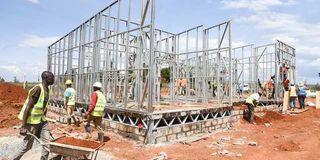
Last week, Navin Patel received an urgent call.
It was an enquiry about whether the proprietor of Vastu Co. Ltd could deliver an urgent housing project.
He would immediately learn that it was a high-profile government project in honour of the fallen globally celebrated Kenyan athlete Kelvin Kiptum.
The world marathon record holder died on February 12 alongside his coach Garvais Hakizimana in a road crash at Kaptagat area along the Elgeyo Marakwet-Ravine road.
The task was to deliver a three-bedroom house for the star athlete within exactly seven days.

Workers during construction of a house for world marathon record holder Kelvin Kiptum, who died together with his coach Gervais Hakizimana in a road crash at Flax on the Eldoret-Kaptagat-Eldama Ravine road on Sunday night, at his farm in Naiberi, Uasin Gishu County on February 17, 2024.
The project site was a four-acre parcel where Kiptum was planning to construct a house for his family at Naiberi, Uasin Gishu County, before his tragic death.
On February 15, Vastu Co. Ltd received the go-ahead to start the project, and Patel and his team hit the ground running.
Of essence was to ensure maximum use of time to deliver a quality product within strict timelines.

Workers construct the house for the late World Marathon record holder Kelvin Kiptum at his farm in Naiberi, Uasin Gishu County on February 18, 2024.
Patel would instantly roll up his sleeves ready for the work, starting with designing the house, assembling his team, and procuring materials required for the project.
The project would be delivered using the light steel gauge technology— the fastest building technology on the construction market today, although not yet common in Kenya.
On Friday, the contractor hit the ground running and by Saturday morning, the team had set up the foundation using the special technology.
On the same day, a truck delivered a specially assembled floor and by evening, the team was wrapping up flooring.

Construction workers hard at work during the construction of a house for world marathon record holder Kelvin Kiptum, who died together with his coach Gervais Hakizimana in a road crash at Flax on the Eldoret-Kaptagat-Eldama Ravine road on Sunday night, at his farm in Naiberi, Uasin Gishu County on February 17, 2024.
Under this technology, the main materials used are steel, ply boards, gypsum, insulation material, cement boards and tiles.
Apart from the plywood used in walling, no timber is used with this technology.
Everything else is standard— including the architectural designs, although the steel and panel specifications are computer generated through a pinnacle software machine, which guides cutting and detailed assembling of the same to specifications before it is transported to the site.
The same can be assembled on-site.

Workers construct the house for the late World Marathon record holder Kelvin Kiptum at his farm in Naiberi, Uasin Gishu County on February 18, 2024.
The technology uses little cement during tiling, and it largely employs dry construction procedures with minimal water usage.
The Nation visited the construction site on Wednesday evening, the sixth day of the project.
The house was 90 percent complete, with wiring, roofing, flooring, and plumbing done, and the team was working on final touches.
The sitting room, which has an open-kitchen setting, was complete with the kitchen having a modern granite sink.
Two cleaners were sprucing up the master bedroom as a team finalised the master washroom installations.
The contractor was mainly fixing the ceiling boards and textured painting in readiness for handover to the government on Thursday (today).
The President William Ruto administration is expected to hand over the house to Kiptum’s widow, Asenath Cheruto, in the presence of the marathoner’s family.
It has taken at least 25 workers to deliver the project, 15 from Vastu Co. Ltd while the rest were locally contracted. They include electricians, plumbers, painters, among others.
Project designer Emmanuel Oteba, who has been overseeing the project alongside his boss Patel took the Nation through the process of assembling the house using the LGS technology, which is considered to be eco-friendly.
According to Oteba, the house design, including the roofing style, considered the weather patterns in the region, as well as the direction of the wind.
“This is the fastest project we have delivered within a week,” Oteba, who has been practicing architecture for the last 15 years, said.
“A lot of thought went into this project design, and it was fully approved based on the set architectural standards.”
The designer said the technology has always drawn excitement.
“This is very versatile and is the fastest we have done. Often, it takes three weeks,” he said, appreciating the effort that has gone into delivering the project.
The contractor constructed other housing units, including Patel’s own residential house in Nairobi and the firm’s Mombasa house, using the same technology 10 years ago.
As they wound up the project on the sixth day, Patel was happy he took up the challenge.
“It was such an honor to be allowed to pay respect to the late athletics hero through delivery of this project,” he said.
“It was quite a challenging task since there was a lot to lose in terms of reputation, but we took it up anyway,” he said.
So, how did he manage to deliver within the tight deadline?
Patel said it took “the favour of God”.
“We had to work on increasing working hours to deliver,” he said, noting the painstaking process through procurement, logistics, and execution.
“The execution went well, although we lost about three to four hours due to logistics and we had to work hard to make up for the projected timelines,” he said.
In total, it took six trips to deliver construction materials from Nairobi.
The LSG technology, Patel said, has a lot of potential for adoption in remote Kenyan areas, mainly because it is fast and involves less logistical costs compared to conventional construction technologies.
“Ninety percent of the construction material is recyclable, and the steel has a low carbon footprint, while the cement production process is carbon-intensive,” he explained.
The cost of construction, he said, depends on the client's preferences as he declined to declare the cost of Kiptum’s unit.
What came out, however, is that it is slightly costlier to construct a house using the LSG technology compared to conventional solutions.
“You are, however, more in control of your construction material using this kind of technology,” Patel said, adding that security and labour cost are also reduced.
Kiptum will be laid to rest at his newly constructed home in Naiberi on February 24.
Unconfirmed reports indicate that the Head of State will pay a visit to the athlete’s Chepsaimo home on Friday before the burial.
On Thursday morning, a funeral procession began from Eldoret Hospital mortuary to Iten for public viewing of the marathoner’s body.







